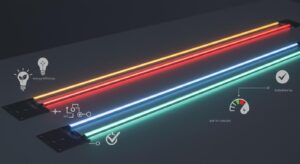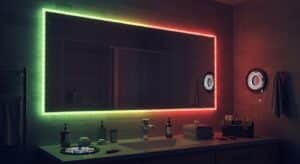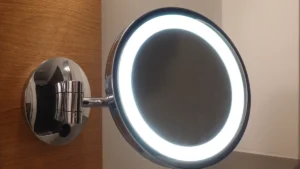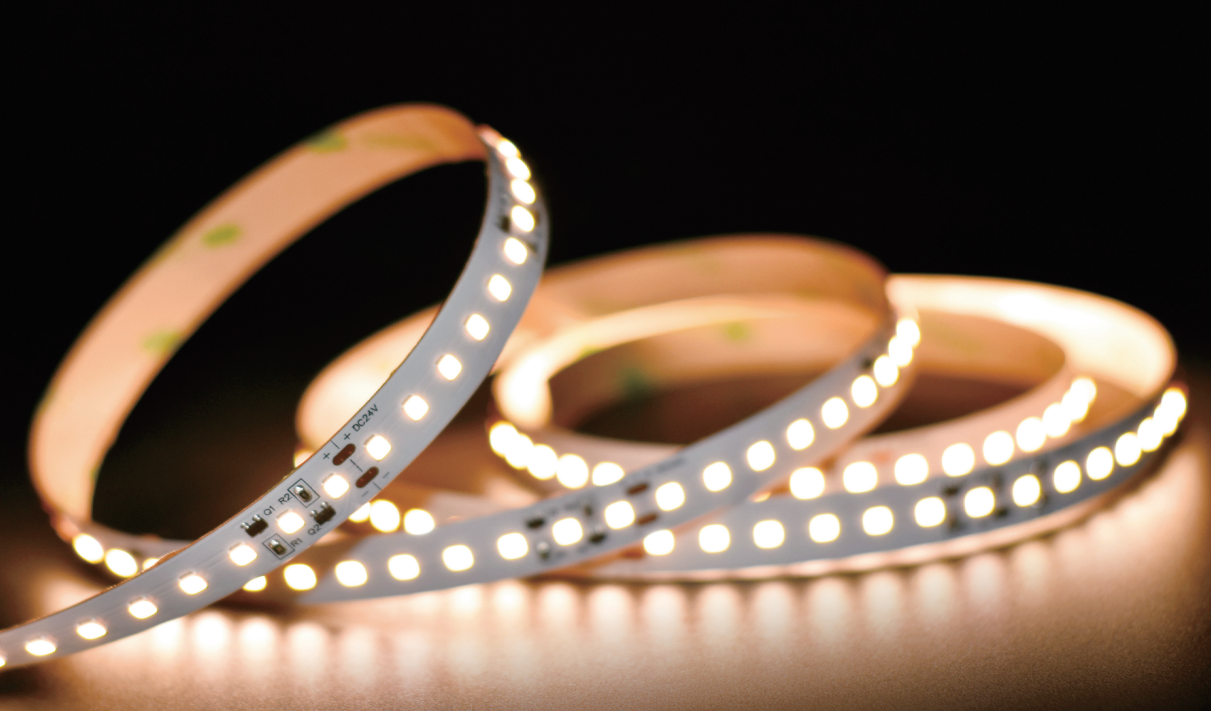
Choosing the right LED light strips can transform your space, but understanding their differences is crucial. The SMD 2835 LED strip stands out for its superior brightness and energy efficiency, producing up to 2000 lumens per meter while consuming less power. In contrast, 5050 LED strips deliver high brightness with three light-emitting chips, making them ideal for vibrant lighting. Meanwhile, 3528 LED strips offer a compact design but lower light output, suitable for subtle accents. Each type excels in specific applications, from ambient lighting to task illumination, ensuring you find the perfect match for your needs.
Key Takeaways
Choose SMD 2835 LED strips for high brightness and energy efficiency, making them ideal for both residential and commercial lighting needs.
Opt for 5050 LED strips if you want vibrant, dynamic lighting with RGB capabilities, perfect for entertainment venues and creative projects.
Use 3528 LED strips for subtle accent lighting where lower brightness is sufficient, making them a cost-effective choice for decorative purposes.
Consider the power consumption of each type: SMD 2835 is the most energy-efficient, while 5050 consumes more power for its brightness.
Evaluate your budget: 3528 LED strips are the most affordable, while SMD 2835 offers great value for performance, and 5050 is best for specialized applications.
Ensure effective heat dissipation by selecting SMD 2835 for prolonged use, while 5050 may require additional cooling in high-intensity setups.
Understanding SMD LED Strips
What is an SMD LED?
An SMD LED (Surface Mounted Device Light Emitting Diode) is a compact and efficient lighting component. Unlike traditional LEDs, SMD LEDs are mounted directly onto a printed circuit board (PCB) using surface mount technology. This design eliminates the need for bulky wiring and allows for a flat, streamlined structure.
The core of an SMD LED consists of a small semiconductor die attached to a lead frame. This lead frame connects to external terminals, which transmit electrical signals to the LED chip. The result is a highly efficient light source that can be integrated into various devices and applications.
SMD LEDs are known for their versatility. They come in different shapes, sizes, and colors, making them suitable for a wide range of uses. From household lighting to industrial applications, these LEDs offer unmatched flexibility. Their compact design also ensures better heat dissipation, which enhances durability and performance.
Why are SMD LEDs popular in lighting applications?
SMD LEDs have gained immense popularity due to their unique advantages. Here are some reasons why they dominate the lighting industry:
High Efficiency: SMD LEDs boast a high lumen-per-watt ratio, meaning they produce more light while consuming less energy. This makes them an energy-efficient choice for both residential and commercial lighting.
Compact Design: Their flat and compact structure allows manufacturers to integrate them into slim and modern lighting fixtures. This design also supports mass production, reducing costs.
Versatility: You can find SMD LEDs in a variety of products, including light bulbs, LED strips, and even electronic devices like mobile phones. Their adaptability makes them ideal for diverse applications.
Cost-Effectiveness: SMD LEDs are affordable without compromising on quality. Their long lifespan and low energy consumption further reduce maintenance and operational costs.
Better Heat Dissipation: The surface-mounted design ensures efficient heat management, which prevents overheating and extends the LED’s lifespan.
“SMD LEDs are the backbone of modern lighting solutions, offering a perfect balance of efficiency, durability, and design flexibility.”
Whether you need ambient lighting for your home or powerful illumination for industrial spaces, SMD LEDs provide a reliable and efficient solution. Their innovative design and performance make them a cornerstone of contemporary lighting technology.
Overview of SMD 2835, 5050, and 3528 LED Strips
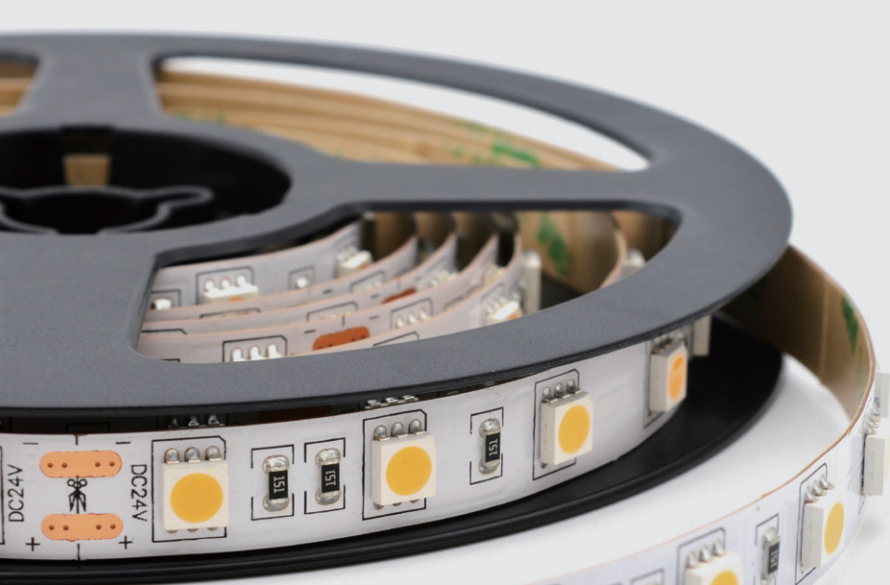
SMD 2835 LED Strip
Features and specifications
The SMD 2835 LED strip is a modern lighting solution designed for efficiency and brightness. Each chip measures 2.8 mm by 3.5 mm, offering a compact size that ensures easy installation in tight spaces. These strips deliver exceptional light output, producing up to 2000 lumens per meter. They operate at lower power levels, typically ranging from 0.2W to 1W per chip, making them highly energy-efficient. The slim profile enhances heat dissipation, which improves durability and performance.
You will find that SMD 2835 strips are available in various color temperatures, from warm white to cool white, allowing you to customize the ambiance of your space. Their design ensures consistent light distribution without dark spots, making them ideal for both functional and decorative purposes.
Common applications
The SMD 2835 LED strip excels in a variety of settings. Its high brightness makes it perfect for primary lighting in rooms, offices, and commercial spaces. You can also use it for task lighting in kitchens, workstations, and garages where focused illumination is essential. The flexible design allows for seamless integration into intricate designs, such as under-cabinet lighting or cove lighting. Whether you need ambient lighting or practical solutions, this strip offers versatility and reliability.
SMD 5050 LED Strips
Features and specifications
5050 LED strips are known for their powerful brightness and vibrant color options. Each chip measures 5.0 mm by 5.0 mm and contains three light-emitting chips in one package. This unique design enables these strips to produce significantly more brightness compared to single-chip alternatives. They are also capable of RGB color mixing, allowing you to create dynamic lighting effects with ease.
These strips consume more power than SMD 2835 or 3528 LED strips, but the trade-off is their superior brightness and versatility. They are robust and durable, making them suitable for demanding environments. You can control the colors and effects using compatible controllers, giving you complete flexibility in your lighting design.
Common applications
5050 LED strips are the go-to choice for vibrant and dynamic lighting projects. You can use them in residential spaces to create colorful accents or in commercial settings to enhance visual appeal. They are also popular in entertainment venues, such as bars and clubs, where dynamic lighting effects are essential. Outdoor installations benefit from their robust design, especially when waterproof versions are used. If you want bold and eye-catching lighting, these strips are an excellent option.
SMD 3528 LED Strips
Features and specifications
3528 LED strips feature a compact design with each chip measuring 3.5 mm by 2.8 mm. These strips are less bright than 5050 LED strips or SMD 2835 LED strips, but they consume less power, making them a cost-effective choice for subtle lighting needs. They typically operate at 4.8W per meter, ensuring energy efficiency while providing adequate illumination for accent lighting.
The design of 3528 LED strips focuses on simplicity and practicality. They are available in single-color options, such as warm white or cool white, and provide consistent light output. Their slim profile makes them easy to install in areas with limited space.
Common applications
3528 LED strips are ideal for accent and decorative lighting. You can use them to highlight architectural features, such as coves, shelves, or staircases. They are also suitable for locations with strong ambient light, where additional brightness is not required. These strips work well in residential and commercial settings, offering a subtle yet effective lighting solution. If you need energy-efficient lighting for decorative purposes, 3528 LED strips are a reliable choice.
Key Differences Between SMD 2835, 5050, and 3528 LED Strips
Size and dimensions
The size of an LED chip directly impacts its performance and suitability for various applications. The SMD 2835 LED strip features chips measuring 2.8 mm by 3.5 mm, offering a compact design that ensures easy installation in tight spaces. In comparison, 5050 LED strips use larger chips, each measuring 5.0 mm by 5.0 mm. This larger size accommodates three light-emitting chips within a single package, enabling higher brightness levels. On the other hand, 3528 LED strips have chips measuring 3.5 mm by 2.8 mm, making them slightly smaller than the 5050 chips but larger than the 2835 chips.
The compact size of the SMD 2835 allows for better heat dissipation performance, which enhances durability. Meanwhile, the larger size of the 5050 LED strip makes it ideal for applications requiring vibrant and dynamic lighting. The 3528 LED strips, with their moderate size, are perfect for subtle accent lighting where space constraints are minimal.
Brightness and light output
When it comes to brightness, the differences between these LED strips become even more apparent. The SMD 2835 LED strip stands out for its superior brightness, producing between 1500 and 2000 lumens per meter. This makes it an excellent choice for spaces requiring high luminous efficiency. 5050 LED strips also deliver high brightness, ranging from 1000 to 1500 lumens per meter. Their triple-chip design ensures vibrant light output, making them suitable for colorful and dynamic lighting effects.
In contrast, 3528 LED strips provide a lower light output, typically ranging from 400 to 700 lumens per meter. While they may not match the brightness of the other two options, they excel in applications where subtle lighting is preferred. For example, you can use them to highlight architectural features or create a cozy ambiance without overwhelming the space.
“If you need maximum brightness, the SMD 2835 LED strip is your best option. For vibrant and colorful lighting, go for 5050 LED strips. Choose 3528 LED strips for soft and decorative lighting.”
Power consumption and energy efficiency
Energy efficiency is a critical factor when selecting LED light strips. The SMD 2835 LED strip leads the pack in this category, consuming less power while delivering high brightness. Each chip operates at power levels ranging from 0.2W to 1W, ensuring optimal energy efficiency. This makes it a cost-effective choice for both residential and commercial applications.
5050 LED strips, while brighter, consume more power due to their triple-chip design. They are less energy-efficient compared to the SMD 2835, but the trade-off is their ability to produce vibrant and dynamic lighting effects. 3528 LED strips, on the other hand, consume the least power, typically operating at 4.8W per meter. This makes them an economical option for decorative lighting where high brightness is not required.
When considering energy efficiency, you should balance your needs for brightness and power consumption. The SMD 2835 offers the best combination of brightness and energy efficiency, while the 3528 LED strips are ideal for low-power applications. 5050 LED strips are perfect for situations where brightness takes precedence over energy savings.
Heat dissipation
Heat dissipation plays a crucial role in the performance and longevity of LED strips. When LEDs operate, they generate heat, which must be managed effectively to prevent damage and maintain efficiency. Among the three types, SMD 2835 LED strips excel in heat dissipation due to their compact design and advanced technology. The smaller size of the chips allows for better thermal management, ensuring consistent performance even during prolonged use.
5050 LED strips, with their triple-chip design, produce more heat compared to the other two types. This higher heat output requires careful installation and, in some cases, additional cooling mechanisms to avoid overheating. Despite this, their robust construction helps them handle heat better in demanding environments, making them suitable for high-intensity lighting applications.
On the other hand, 3528 LED strips generate the least amount of heat. Their lower brightness and power consumption contribute to minimal heat production, which makes them ideal for decorative lighting where heat management is less critical. However, their simpler design may not dissipate heat as efficiently as the SMD 2835.
“Effective heat dissipation ensures your LED strips last longer and perform optimally. Choosing the right type based on your needs can save you from potential overheating issues.”
Cost-effectiveness
Cost-effectiveness is a key factor when selecting LED strips. SMD 2835 LED strips offer an excellent balance between price and performance. Their high brightness and superior energy efficiency make them a cost-effective choice for both residential and commercial applications. You get more lumens per watt, which translates to lower electricity bills over time.
5050 LED strips tend to be more expensive due to their triple-chip design and higher brightness. While they consume more power, their ability to produce vibrant and dynamic lighting justifies the cost for specific applications like entertainment venues or outdoor installations. If you prioritize brightness and versatility, the investment in 5050 LED strips can be worthwhile.
3528 LED strips are the most affordable option among the three. Their lower brightness and power consumption make them a budget-friendly choice for subtle accent lighting. These strips are perfect for projects where cost savings take precedence over high light output.
When evaluating cost-effectiveness, consider the long-term benefits. SMD 2835 LED strips provide the best value for general use, while 5050 LED strips are ideal for specialized applications. 3528 LED strips offer an economical solution for decorative purposes.
“Balancing upfront costs with long-term savings is essential. Choose the LED strip that aligns with your budget and lighting requirements.”
Comparison Table
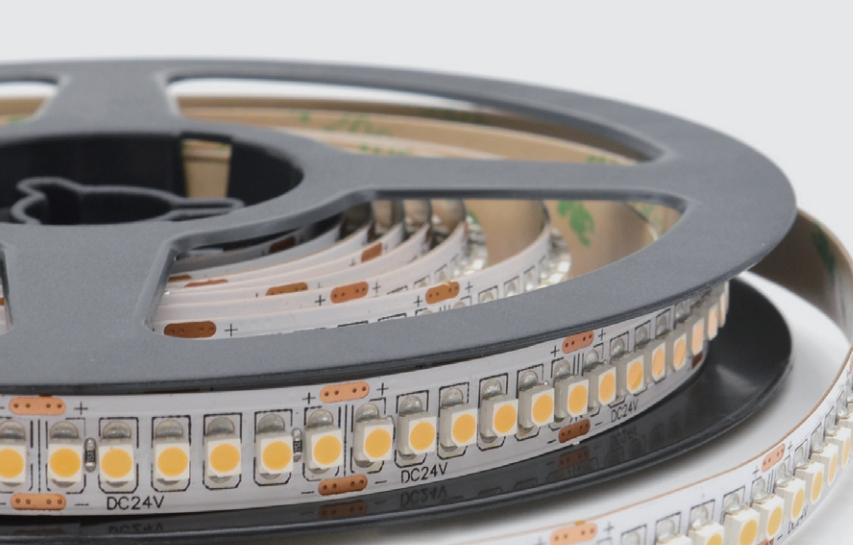
Side-by-side comparison of SMD 2835, 5050, and 3528 LED strips
When choosing the right LED light strips, a clear comparison of their features can help you make an informed decision. Below is a detailed side-by-side comparison of SMD 2835, 5050 LED strips, and 3528 LED strips based on key factors.
Dimensions
The size of the LED chips directly impacts their performance and application. SMD 2835 chips measure 2.8 mm by 3.5 mm, offering a compact design that fits well in tight spaces. 5050 LED strips, with chips measuring 5.0 mm by 5.0 mm, are larger and accommodate three light-emitting chips in one package. This design supports their ability to produce high brightness. 3528 LED strips feature chips measuring 3.5 mm by 2.8 mm, making them slightly smaller than the 5050 chips but larger than the 2835 chips. Their moderate size makes them suitable for subtle accent lighting.
“The compact size of SMD 2835 ensures better heat dissipation, while the larger 5050 chips excel in delivering vibrant lighting.”
Brightness (lumens per watt)
Brightness is a critical factor when selecting LED strips. SMD 2835 LED strips deliver superior brightness, producing up to 200 lumens per watt. This makes them highly efficient for spaces requiring strong illumination. 5050 LED strips also provide high brightness, with a typical output of 100-150 lumens per watt. Their triple-chip design enhances their ability to create vibrant and colorful lighting effects. In contrast, 3528 LED strips offer a lower light output, averaging around 50-80 lumens per watt. While they may not match the brightness of the other two, they are ideal for decorative purposes.
Power consumption (watts per meter)
Energy efficiency varies across these LED strips. SMD 2835 LED strips consume less power, typically operating at 8-10 watts per meter, while still delivering excellent brightness. 5050 LED strips, due to their triple-chip design, consume more power, ranging from 14-18 watts per meter. This higher consumption supports their vibrant lighting capabilities. 3528 LED strips are the most energy-efficient, consuming only 4.8 watts per meter. This makes them a cost-effective choice for applications where brightness is not the primary concern.
Heat dissipation
Effective heat dissipation ensures the longevity and performance of LED strips. SMD 2835 LED strips excel in this area due to their compact design, which allows for efficient thermal management. 5050 LED strips, while producing more heat because of their triple-chip structure, are built to handle demanding environments. Proper installation and cooling mechanisms can further enhance their performance. 3528 LED strips generate minimal heat due to their lower brightness and power consumption, making them suitable for decorative lighting where heat management is less critical.
Cost per meter
Cost is often a deciding factor when selecting LED strips. SMD 2835 LED strips strike a balance between price and performance, offering high brightness and energy efficiency at a reasonable cost. 5050 LED strips are more expensive due to their advanced design and vibrant lighting capabilities. However, their cost is justified for applications requiring dynamic lighting. 3528 LED strips are the most affordable option, making them ideal for budget-conscious projects focused on accent lighting.
“Balancing cost with performance is essential. SMD 2835 offers the best value for general use, while 5050 LED strips are perfect for vibrant lighting. For decorative purposes, 3528 LED strips provide an economical solution.”
Advantages and Disadvantages of Each LED Type
SMD 2835 LED Strip
Pros
High Brightness: The smd 2835 led strip delivers exceptional light output, producing up to 200 lumens per watt. This makes it ideal for spaces requiring strong illumination.
Energy Efficiency: Each chip operates at only 0.2 watts, ensuring minimal power consumption while maintaining excellent brightness.
Compact Design: The small chip size (2.8 mm by 3.5 mm) allows for better heat dissipation and easy installation in tight spaces.
Cost-Effective: It offers a great balance between price and performance, making it a practical choice for both residential and commercial applications.
Versatility: Available in various color temperatures, it suits a wide range of lighting needs, from ambient to task lighting.
“The smd 2835 led strip combines efficiency, brightness, and affordability, making it a top choice for modern lighting solutions.”
Cons
Limited Color Options: Unlike RGB-capable strips, it primarily focuses on single-color lighting, which may not suit decorative or dynamic lighting needs.
Moderate Durability: While efficient, its compact design may not handle extreme conditions as robustly as larger chips like the 5050.
SMD 5050 LED Strips
Pros
Superior Brightness: With three light-emitting chips in one package, these strips produce vibrant and dynamic lighting, perfect for high-intensity applications.
RGB Capability: The ability to mix red, green, and blue colors allows you to create stunning lighting effects and customize your ambiance.
Durability: The robust design ensures reliable performance in demanding environments, including outdoor installations.
Versatile Applications: These strips excel in entertainment venues, commercial spaces, and even residential settings where bold lighting is required.
“For vibrant and colorful lighting, the 5050 LED strips stand out as a versatile and powerful option.”
Cons
Higher Power Consumption: The triple-chip design consumes more energy, typically ranging from 14 to 18 watts per meter, which may increase electricity costs.
Generates More Heat: The higher brightness output results in increased heat production, requiring careful installation and, in some cases, additional cooling mechanisms.
Higher Cost: These strips are more expensive than other options, which may not suit budget-conscious projects.
SMD 3528 LED Strips
Pros
Energy Efficiency: Operating at just 4.8 watts per meter, these strips consume the least power, making them an economical choice for decorative lighting.
Compact Size: The chip dimensions (3.5 mm by 2.8 mm) allow for easy installation in areas with limited space.
Affordable: These strips are the most budget-friendly option, perfect for accent lighting or projects with cost constraints.
Minimal Heat Generation: The lower brightness and power consumption result in reduced heat output, ensuring safe and long-lasting use.
“The 3528 LED strips offer a simple and cost-effective solution for subtle and decorative lighting needs.”
Cons
Lower Brightness: With a light output of 50 to 80 lumens per watt, these strips are not suitable for spaces requiring strong illumination.
Limited Applications: Their single-color design and lower brightness restrict their use to accent and decorative purposes.
Less Durable: The simpler design may not withstand harsh conditions as effectively as the 2835 or 5050 strips.
Choosing the Right LED Strip for Your Needs
Selecting the right LED light strips can significantly impact the functionality and aesthetics of your space. To make an informed decision, you need to evaluate several factors and match them with your specific requirements. Below, we break down the key considerations and provide tailored recommendations for various applications.
Factors to consider
When choosing LED strips, focus on these essential factors:
Brightness: Assess the level of illumination you need. For spaces requiring high brightness, such as workstations or commercial areas, opt for 5050 LED strips. If you need moderate brightness with excellent energy efficiency, 2835 LED strips are a great choice. For subtle accent lighting, 3528 LED strips provide just the right amount of light.
Energy Efficiency: Consider how much power the strips consume. 2835 LED strips strike a balance between brightness and energy efficiency, making them ideal for long-term use. 3528 LED strips consume the least power, making them perfect for decorative purposes. 5050 LED strips, while less energy-efficient, deliver unmatched brightness for demanding applications.
Budget: Determine how much you are willing to spend. 3528 LED strips are the most affordable option, suitable for cost-conscious projects. 2835 LED strips offer excellent value for money with their superior performance. 5050 LED strips, though pricier, justify their cost with vibrant lighting and versatility.
应用: Match the strip type to your intended use. Whether you need lighting for residential, commercial, decorative, or outdoor purposes, each strip type has unique strengths.
Durability and Heat Dissipation: For prolonged use, choose strips with efficient heat dissipation. 2835 LED strips excel in this area, ensuring longevity and consistent performance. 5050 LED strips handle heat well but may require additional cooling in high-intensity setups. 3528 LED strips, with their lower heat output, are suitable for less demanding environments.
“Understanding your needs and evaluating these factors will help you choose the perfect LED strip for your space.”
Understanding the differences between LED strips helps you make informed decisions. The smd 2835 led strip offers high brightness and energy efficiency, making it ideal for versatile applications. For vibrant and dynamic lighting, 5050 strips excel with their triple-chip design. Meanwhile, 3528 led strips provide subtle illumination, perfect for decorative purposes. Evaluate your needs based on brightness, energy consumption, and budget. Balance these factors to achieve optimal results. Whether you need functional lighting or decorative accents, selecting the right strips ensures a perfect fit for your space.
FAQ
What are the main differences between SMD 2835, 5050, and 3528 LED strips?
The primary differences lie in size, brightness, power consumption, and applications. SMD 2835 LED strips are compact and energy-efficient, delivering high brightness. 5050 LED strips feature a triple-chip design, producing vibrant and dynamic lighting. 3528 LED strips are smaller and less bright, making them ideal for subtle accent lighting. Understanding these distinctions helps you choose the right strip for your needs.
Which LED strip is the brightest?
5050 LED strips produce the most light due to their triple-chip design. They generate three times more brightness than 3528 LED strips of the same size and density. However, SMD 2835 LED strips also offer impressive brightness with better energy efficiency, making them a strong contender for spaces requiring high illumination.
Are SMD 2835 LED strips more energy-efficient than 5050 LED strips?
Yes, SMD 2835 LED strips consume less power while delivering excellent brightness. Each chip operates at 0.2W to 1W, ensuring optimal energy efficiency. In contrast, 5050 LED strips consume more power, typically ranging from 14W to 18W per meter, due to their triple-chip design.
Can I use 3528 LED strips for primary lighting?
3528 LED strips are not suitable for primary lighting. Their lower brightness, averaging 50-80 lumens per watt, makes them better for decorative or accent lighting. For primary lighting, consider SMD 2835 or 5050 LED strips, which provide higher brightness levels.
What makes 5050 LED strips ideal for RGB lighting?
The triple-chip design of 5050 LED strips allows them to mix red, green, and blue colors seamlessly. This feature enables dynamic lighting effects and customizable color options, making them perfect for entertainment venues, parties, or creative projects.
Which LED strip is the most cost-effective?
SMD 2835 LED strips offer the best balance between price and performance. They provide high brightness and energy efficiency at a reasonable cost. 3528 LED strips are the most affordable option but are limited to decorative purposes. 5050 LED strips, while more expensive, justify their cost with vibrant lighting and versatility.
How do I choose the right LED strip for my project?
Consider these factors:
Brightness: Choose SMD 2835 for high brightness, 5050 for vibrant effects, or 3528 for subtle accents.
Energy Efficiency: Opt for SMD 2835 for the best balance of brightness and power consumption.
Budget: Select 3528 for affordability, SMD 2835 for value, or 5050 for specialized applications.
应用: Match the strip type to your needs, such as residential, commercial, or decorative lighting.
“Understanding your project’s requirements ensures you select the most suitable LED strip.”
Do LED strips generate heat?
Yes, all LED strips generate some heat during operation. SMD 2835 LED strips excel in heat dissipation due to their compact design. 5050 LED strips produce more heat because of their triple-chip structure, requiring proper installation. 3528 LED strips generate minimal heat, making them safe for decorative use.
Are LED strips waterproof?
Some LED strips, including SMD 2835, 5050, and 3528, come in waterproof versions. These are ideal for outdoor or moisture-prone areas. Always check the IP rating to ensure the strip meets your specific requirements.
Can I cut LED strips to fit my space?
Yes, most LED strips, including SMD 2835, 5050, and 3528, can be cut at designated points. This feature allows you to customize the length to fit your project. Always follow the manufacturer’s guidelines to avoid damaging the strip.
See Also
Comparing Flexible Versus Rigid LED Strip Lights
2024’s Best LED Strip Lights: Features And Costs Reviewed
Choosing The Perfect LED Strip Lights For Linear Lighting
